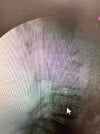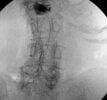- Joined
- Aug 25, 2008
- Messages
- 189
- Reaction score
- 46
Hello again everyone!
I have some questions about TFESIs that have been causing me stress.
1.) I go typically at the neck of the scotty dog and try to walk off. Typically line up end plate and oblique 20-25 on average. Some how on AP I am frequently ending up too medial, past 6'o'clock on pedicle. What am I doing wrong?
2.) What techniques do you use if there is significant arthritis preventing you from entering in the technique mentioned above? Do you go infraneural?
3.) What is best way to have success at L5-S1, I find this area often has significant arthritis etc and prevents me from entering correctly
4.) If a patient has a sacaralized L5, can you enter as if it was a traditional S1? and if a Lumbarized sacrum do you enter as a traditional lumbar TFESI? Or would you just do a Interlaminar at that level as the in theory the ligament should be fine. Thanks so much everyone.
I have some questions about TFESIs that have been causing me stress.
1.) I go typically at the neck of the scotty dog and try to walk off. Typically line up end plate and oblique 20-25 on average. Some how on AP I am frequently ending up too medial, past 6'o'clock on pedicle. What am I doing wrong?
2.) What techniques do you use if there is significant arthritis preventing you from entering in the technique mentioned above? Do you go infraneural?
3.) What is best way to have success at L5-S1, I find this area often has significant arthritis etc and prevents me from entering correctly
4.) If a patient has a sacaralized L5, can you enter as if it was a traditional S1? and if a Lumbarized sacrum do you enter as a traditional lumbar TFESI? Or would you just do a Interlaminar at that level as the in theory the ligament should be fine. Thanks so much everyone.











